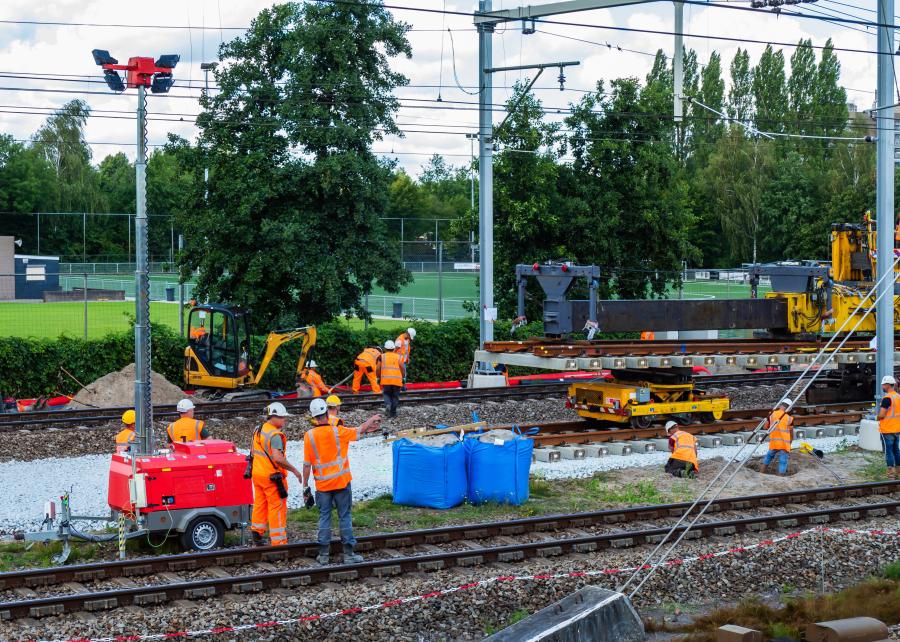More college-bound people are opting to enter apprenticeship programs.
A convergence of factors may mean a boost for construction employers trying desperately to fill jobs. The cost of a college education and a rewrite of the National Apprenticeship Act are giving a boost to the industry's labor pool. As many people choose to forego four years of college to start work, apprenticeship programs are becoming a more enticing route to construction careers.
Demand for workers, rising cost of college tuition and burdensome student loans, have apprenticeship programs "quietly gaining steam," according to a CNBC report.
"People at the margin are saying ‘I don't know if I can wait four years to make a living,'" said Hafeez Lakhani, president of Lakhani Coaching in New York.
European Model
The apprenticeship tradition of combining on-the-job, paid training with classroom instruction has its roots in European history.
In Germany alone, more than half of all high school graduates participate in an apprenticeship program. Yet it's been slow to catch fire in the United States, according to a National Student Clearinghouse report.
The DOL figures more than 581,000 people were in a registered apprenticeship program this year. That's a 103 percent increase over the decade. However, 12 million people are enrolled at a four-year school today, according to a Captimes news organization article.
David Boetcher of IBEW 159 in Madison, Wis., said the idea of pursuing a college education is ingrained in American high school graduates.
Meanwhile, lucrative jobs requiring shorter, less expensive training go unfilled. But the tide may be turning, he told Captimes.
"People are seeing that a college degree, while being asked for by every employer, isn't as necessary, and it's gotten horrifyingly expensive."
"Apprenticeship helps to get people into workspaces with very succinct training," said David Polk, Wisconsin Department of Workforce Development.
That model of programmatic training "encompasses the job learning and classroom learning to take a person from novice to skilled," he said in the Captimes article.
"Employers are hungry for young talent and new talent, and they are just more open to going down the path of apprenticeship models in the skilled trades."
Over the past 50 years, "there's been a shift away from the occupations that people do [in] this narrow focus of college," said Pete Stern, Madison ironworkers union.
"It's great to be a pharmacist, doctor, lawyer, accountant, but they have to have buildings to do them, and people are starting to realize that," he said.
Funding Where It Counts
As a result, the push to shed a brighter light on the benefits of apprenticeships is gaining support at both the state and federal level.
In April, a bipartisan group of House education and workforce committee members introduced the National Apprenticeship Act of 2023. Creating near one million registered, youth and pre- apprenticeship opportunities over five years, it earmarks almost $4 million for the cause.
"The Registered Apprenticeship system is one of the best tools we have to connect workers with in-demand skills with good-paying jobs," said committee ranking member Bobby Scott of Virginia.
At the same time, the system provides employers with a pipeline of talented workers, he added.
"The National Apprenticeship Act of 2023 is a clear win-win for workers and employers, and it will help grow the economy."
The proposed legislation authorizes $400 million in funding for fiscal year 2025, increasing by $100 million annually to $800 million for FY 2029.
The Act codifies and streamlines standards for registered, youth and pre-apprenticeship programs. That includes requirements for apprenticeship agreements and program registration to ensure consistency in quality standards and worker protections. It codifies existing regulations and practices to ensure that all individuals have an equal opportunity to participate in programs under the national system.
It also works to increase diversity in the occupations offered and the individuals participating in programs. It codifies the DOL's Office of Apprenticeship as well as the responsibilities of the State Apprenticeship Agencies.
The agreement supports the creation and expansion of youth apprenticeships, college consortiums and data sharing agreements.
Last fall, President Biden launched the Apprenticeship Ambassador Initiative, a network of businesses and organizations supporting registered apprenticeship. The more than 200 businesses and organizations have existing registered apprenticeship programs in more than 40 industries.
They have committed to expand and diversify these programs over the next year, according to the Biden administration. They will develop 460 new programs, hire more than 10,000 new apprentices and hold 5,000 outreach, promotional and training events.
The goal is to help other business, labor and education leaders launch similar programs.
"Ambassadors will also use their expertise to scale innovative practices and increase access to registered apprenticeship for underserved populations," said President Biden.
The administration touts the program as a high-quality, debt-free equitable "earn and learn" model with a nationally recognized credential system. They maintain the program "helps employers hire a more diverse workforce."
Improved Employee Retention
The program also provides workers with on-the-job learning experience, job-related instruction with a mentor and a clear pathway to a good-paying job. It builds on Biden's efforts to expand registered apprenticeships, including investing hundreds of millions of dollars in them.
The initiative aims to launch an apprenticeship accelerator to speed new program approval from months to days.
Open Campus reports that apprenticeships are becoming the darling of labor. "Everybody wants to do it," said Mary Alice McCarthy of New America.
The big question said McCarthy, senior director of New America's center on education and labor at New America, is "Where do you put the money?"
One solution floated is to channel more public support for "apprenticeship intermediaries" to help set up and run the programs.
Nonprofit group Apprenticeships for America said nonprofits, for-profits or public institutions are potential candidates.
Intermediaries are "going to be able to recruit the apprentices, the employers and stitch it all together," McCarthy told Open Campus.
Jennifer Carlson of career service Apprenti describes the group as a consortium of 80 apprenticeship-delivery organizations across industries. She said apprenticeship training "allows for people with nontraditional work skills to find an alternate pathway into high-demand, high-wage roles."
Trident Technical College, a two-year institution located in South Carolina, is one intermediary currently in partnership with local K-12 schools.
Employers are invested, said Melissa Stowasser, assistant vice president of community partnerships at the college.
"The employers have skin in the game" and are paying the salaries and providing mentors to apprentices, she said. "They are committed."
For Tom Howard, owner of Lee's Air in Madison, Wis., the program was meant to address a growing labor shortage.
"The reality is, as air-conditioning and plumbing companies, we are desperate for labor," he said. "It's a massive problem."
Lee's covers the cost of training and supplies and matches apprentices with full-time jobs at the company. Once workers complete the program, "we have a pretty high retention rate," he said.
But these days, apprenticeships are becoming more mainstream across the industry, Howard added.
"Companies that have these programs have a huge advantage because we can create the labor."
It's all a win-win for the employer and the apprentice, said Polk of the Wisconsin DWD. Employers ensure they have a skilled, productive workforce, and apprentices get paid for on-the-job training that advances them into the professional world.
Biden maintains his initiative will have long-lasting and economic benefits. But not everyone in the construction industry agrees.
One-Sided Approach
The Associated Builders and Contractors (ABC) organization is vocal about its objections to the narrow focus of Biden's initiative.
The association said it would take 12 years for government-registered apprenticeship programs (GRAP) to make a dent the more than half a million worker void the industry needs to fill right now.
Instead, ABC has gotten behind other workforce legislation, including Training America's Workforce and the Freedom to Invest in Tomorrow's Workforce
ABC estimates that the industry's GRAP system yielded just 45,000 workers who completed four- to five-year apprenticeship programs last year.
"Construction of American infrastructure, funded by robust investments will be delayed, subject to added costs or not built at all," said Ben Brubeck, ABC vice president of regulatory, labor and state affairs.
That's unless lawmakers champion all-of-the-above workforce development policies for the construction industry, he said.
"Unfortunately, the Biden administration and some in Congress are pushing policies exclusively promoting GRAP to build the construction workforce."
This benefits special interests, said Brubeck, because 75 percent of all GRAP enrollees are affiliated with union programs.
"Yet, the government's own data demonstrates that the restrictive GRAP system is not meeting the industry's need for skilled labor," he added.
It "therefore cannot be the only solution supported by government to meet market demand and develop a diverse and inclusive workforce."
A May DOL listening session on the National Apprenticeship System rewrite "could result in new restrictive policies favoring special interests at the expense of the broader construction industry," said Brubeck.
ABC said the national apprenticeship act "further entrenches" the "rigid" system and fails to address workforce needs of the nation's construction industry.
It also "substantially restricts apprenticeship opportunities currently serving thousands of contractors, the association maintains," said the association.
"ABC's 68 chapters are educating craft, safety and management professionals using innovative and flexible learning models."
That's in addition to more than 300 GRAPs across more than 20 different occupations with a goal to develop a safe, skilled and productive workforce.
"ABC member companies administer GRAPs independent of ABC's network," said Brubeck.
Members invested an estimated $1.6 billion in construction industry workforce development in 2021, he added.
"GRAPs are one of many solutions that are part of ABC's all-of-the-above solution to workforce development," said Brubeck. CEG
Lucy Perry
Lucy Perry has 30 years of experience covering the U.S. construction industry. She has served as Editor of paving and lifting magazines, and has created content for many national and international construction trade publications. A native of Baton Rouge, Louisiana, she has a Journalism degree from Louisiana State University, and is an avid fan of all LSU sports. She resides in Kansas City, Missouri, with her husband, who has turned her into a major fan of the NFL Kansas City Chiefs. When she's not chasing after Lucy, their dachshund, Lucy likes to create mixed-media art.
Read more from Lucy Perry here.
Today's top stories

















